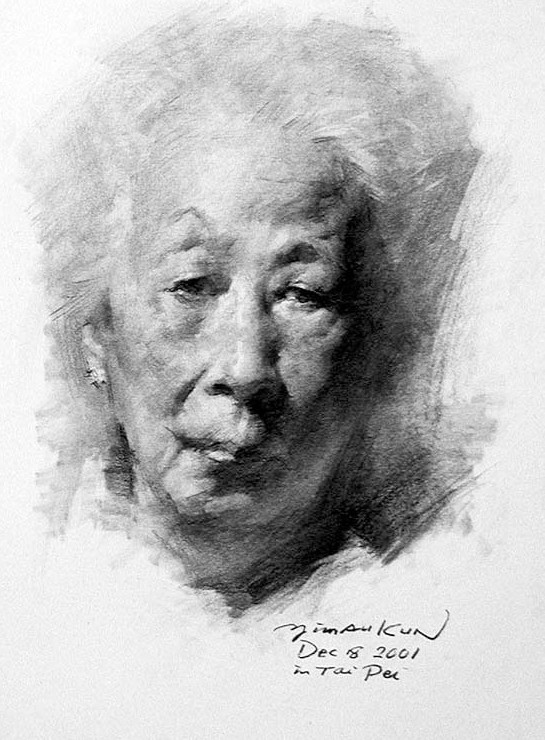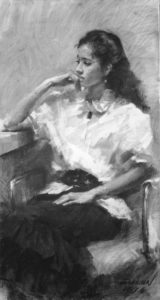I was a student at the Affiliated High School of the Guangzhou Academy of Fine Arts in the early 1960s. When I first saw the drawings of the human form that Prof. Guo Shaogang (郭紹綱) brought back after studying in the Soviet Union as an exchange student, I was absolutely stunned! In the summer of that same year, I traveled to Beijing and visited the Xu Beihong Memorial Hall where I saw many of the original drawings made by the great master. Drawing has been my lifelong passion ever since. In the 1990s, I visited Europe and the U.S. There I gave particular attention to the drawings of Da Vinci, Raphael, Rembrandt, Ingres, Degas and Van Gough in the major art museums. I recently flew all the way to Russia to admire the great paintings by Chistyakov, Repin, Serov and Vrubel as well as the collection of the Repin Academy of Fine Arts. I feel as if I had followed in the foot steps of the great masters in taking cruise down the long river of drawing. The sights along the river are breathtaking to behold.
回憶起20世紀60年代初,我正在廣州美術學院附中唸書,當首次見到郭紹綱教授自蘇聯留學帶回的人體素描時,我真是受到了極大的震動!同年夏天又赴北京,參觀了徐悲鴻紀念館,目睹大師好多素描原作。從此,我就被素描深深地吸引住了。90年代,我先後赴歐洲、美國,在各大美術館中,特別留意了達.芬奇、拉斐爾、倫勃朗、安格爾、德加、凡.高的素描作品。最近,又遠飛俄羅斯,將契斯恰柯夫、列賓、謝洛夫、弗魯別爾及列賓美術學院陳列館中的優秀畫作一一拜讀。至此,我彷彿沿著大師們的足跡,遊覽了素描的長河,這長河兩岸景色綺麗,美不勝收。
I moved to Hong Kong twenty years ago then settled down in Taipei a few years after that. Due to popular demand and to make a living, I opened my teaching studio and became an educator. My work in art education over the years meant I accumulated many drawings and made some progress. Confucius was right when he said: “Isn’t there not joy in learning?” I at least enjoyed the exploration of drawing. In continuing to re-examine and think about Realist painting and the teaching of drawing over the years, I gained a better idea of my path in art and enriched my own mind as well.
20年前,我移居香港,幾年後定居台北,或為謀生或應眾要求而開設畫室,作畫之餘兼事教育。多年來斷斷續續的美術教育工作,使我累積了不少素描畫作,也有所長進。孔子曰“學而時習之,不亦樂乎”,真是一點不錯啊!我是樂在素描,至少,享受了素描探索的過程。在這些年,我對素描本身,對寫實繪畫和素描教學的種種再做檢視和思考,不僅清晰了藝術的道路,也深化了自己的思想。
I will briefly outline some challenges that I often come across for discussion.
The legacy of Western Realist painting.
It was not until the Italian Renaissance Period that Western painting evolved beyond two-dimensions with its planes and lines into the three-dimensions with solids, light and shadow that now characterize Western painting. This painting system was developed through the exploration of many artists and represents the cultural knowledge accumulated by mankind. In other words, it is not inborn knowledge. It must be taught and studied in a systematic manner. It cannot be easily obtained through so-called “genius” alone.
下面我將經常碰到的問題,作簡略性的敘述,以此與美術青年晤談。
西洋寫實繪畫的傳承。
西洋繪畫,發展到意大利文藝復興時期,才從平面、線性的二度空間方式進入到立體、光影的三度空間方式,並成為西方繪畫的主流型式。這一繪畫體系是由好多藝術家探索而形成的,是人類累積性的文化知識,也可以說是非先天性的知識,需要系統地傳授和學習,不能憑所謂“天才”輕易獲得。
Drawing is fundamental to painting.
For traditional Western painting this conclusion still holds true. The emergence of the Modernist school as well as the Impressionist efforts to develop human color perception from the 19thCentury onwards led to drawing being neglected at one point in European and American art education. Leaving the modern schools aside, drawing continues to be fundamental to Realist painting. It is in fact of the utmost importance because it solves all problems related to form outside of the color factors. Artists interested in Realism should keep this in mind.
素描是繪畫的基礎。
對於傳統西洋畫來說,這個結論仍然是對的。19世紀以後,因為現代派的興起和印象派對人類色感能力的開發,在歐、美的藝術教育中,素描一環受到忽略。現代諸流派不論,對於寫實繪畫,素描仍是基礎,是第一重要的,因為它解決了色彩因素外所有的造型問題。有志於寫實繪畫的青年絕不可以輕忽。
So what is in drawing?
Proportions, perspective, blocks and spaces are the essential elements of drawing. We study the relationship between these elements and explore how they fit together to define the bulk of objects and how they occupy space; we delve into the forms of art that give shape to this state such as lines, colors and brushwork. Applying all of the above to the depiction of structure and texture as well as expressions and psychology during the drawing of the human anatomy and characters represent an important topic in the study of drawing.
素描研究的內涵是甚麼?
比例、透視、體塊、空間等是素描的本質因素。研究這些因素之間的關係,探討這些因素如何“咬合”著體現物體的體積形及空間佔有的狀態;探索體現這種狀態的藝術形式:線條、色調和筆觸,並把這一切調動到人體素描、人物素描中對結構、質感以及表情、心理的刻劃上,是素描研究的重要課題。
Is sense or sensibility the more important during drawing?
The Russian art educator Chistyakov said that drawing is about sense though this mainly applies to color. Sense, analysis and comprehension are emphasized in drawing because ignorance of perspective and anatomy often leads to vacuity and weak compositions. Drawing is an art however so sensibility cannot be ignored either and must be applied throughout the drawing process. One must draw and sculpt. Making a study does not mean being “pedantic” about every detail. It is impossible for a “pedantic” artist to create oil paintings that feel like a painting and speak to the emotions.
寫實畫式微了嗎?
我親眼目睹世界各類美術館和畫廊中,大多數參觀者喜歡的畫還是寫實風格的,是他們看得懂的繪畫。但是,無可諱言,今天寫實畫的水平是大大低落了。原因是多方面的,照相機的過度使用是其中之一。照相機自19世紀中葉發明以來,對寫實西畫有重大的幫助,它作為對快速易逝的形象和細節的紀錄工具,於畫家不無助益,但是,卻往往限制了畫家想像力和概括力的發展。不少人依賴照相機的結果是生產了大量酷似照片的畫面,畫中充斥著不必要的細節。畫家不寫生了,“君王從此不早朝”,如此景象,令人不勝感慨!
Is Realism a dying art form?
I’ve seen with my own eyes how most visitors to art museums and galleries around the world still prefer paintings in the Realist style. They understand this kind of painting. One must admit to a great decline in the standard of Realist painting today. There are many factors at work and one of them is the over-use of the camera. The camera has been a boon to Realist painting in the West since it was invented in the mid-19thCentury. It provides painters with a very useful tool for recording ephemeral images and details. On the other hand, it often hampers the development of the painter’s own imagination and observation skills. The reliance of many people on the camera resulted in a flood of images that look like photographs. Such paintings are filled with unnecessary details. Like “a king who no longer bothers with morning audiences”, painters no longer bothered with plein-air painting. What a tragic state of affairs.
素描過程中理性與感性孰輕孰重?
俄國美術教育家契司恰柯夫說素描是理性的,這是相對色彩而言。素描偏重理性,偏重分析和理解。因為沒有透視、解剖知識的支撐,它常常會流於空泛和造型的鬆散。但是,素描既是藝術就離不開感性,而且要將感性貫通於素描的全過程。要畫出來,要塑造,不要將面面俱到的“死摳”當成是研究。因為,一個“死摳”而匠氣的素描者不可能畫出有感性、有畫味的油畫來。
A return to plein-air painting is the only way to correct this malaise of our time. Traditional drawing was based on plein-air painting of actual objects and the expression of three-dimensional objects on a two-dimensional canvas. This is quite different from transferring a flat photograph to another flat plane. Drawing also eliminates the color factor to maintain a certain distance from the actual object. Plein-air drawing is therefore a good way to avoid falling into the trap of photo realistic paintings. Even if a camera must be used, the visual information provided by the photograph must be carefully screened. Don’t let the photograph take over and make you its “slave.”
要糾正這種時弊,唯有回到寫生一途。素描的傳統方式是對實物寫生,將三度空間的物體表現在二度空間的畫面上。這與將平面化的照片轉移到平面有著極大的差異。素描又摒去了色彩因素,與實物保持了一定的距離感。因而,素描這種寫生方式是去照片畫的重要途徑。另外,即使必須使用照相機,也一定要對照片中提供的影像資料作出審慎的篩選,不要為照片所牽引,成為照片的“奴隸”。
But a drawing can look like a photo, you say. Yes, painting a good likeness does not by itself solve the problem. It must be an artistic likeness that has aesthetic value. This brings up the question of descriptiveness versus expressiveness. The core of descriptiveness is the “artistic rhythm.” There can be no art without rhythm. Rhythm is change – contrast and unity. In painting, rhythm takes the form of layers on a plane and all the different forms of brush work. One must be able to sense all the different textures in the subject in order to translate an actual object to the drawing paper or canvas – the conversion of living reality to artistic reality is necessary to breathe life into what is being described in the image. The painting ability of each person is mainly expressed through their mastery of form and sensitivity to rhythm. The training of both senses and skills is essential. The expression of rhythm is what truly separates craftsman from painter.
素描也可能畫得像照片呀。確實,光是畫得像還是不能解決問題,還要藝術地像,富於美感。這又牽扯到繪畫中的描繪性和趣味性問題。描繪性的核心是“藝術節奏”,無節奏不成藝術,節奏就是變化,是對立統一。節奏的外在形式是繪畫材質在平面上的表層狀態,是各種型態的筆觸。只有從對象感覺到虛實、型態各異的筆觸,才能完成實物到畫面的轉化--生活真實到藝術真實的轉化,才能帶動出在畫面上的主動性描繪。一個人的繪畫才能,主要表現在對形的把握和對節奏的敏感上,這兩種感覺與能力的訓練缺一不可。尤其是對節奏感的表現,更是畫匠與畫家的分水嶺。
Form and structure, mass and space, brush work and rhythm are all there to capture and shape the artistic image. Artistic image is the carrier of our thoughts and emotions. It is also the goal of artistic pursuits. When we look at the history of art in the East and West, the greatest artworks have all won renown and enduring fame through their vivid and thought-provoking artistic image. The shaping of the artistic image takes more than just skill and technique. It takes a sincere and sensitive heart – the sophistication and inspiration of a true artist. This is something that even the best art education cannot provide. It is something that we must cultivate and learn for ourselves.
當然,形與結構、體積與空間、筆觸與節奏,都是為了去捕捉、塑造藝術形象的。藝術形象是我們思想、感情的載體,也是藝術行為追求的目的。綜觀古今中外的美術史,所有的藝術傑作無不以鮮明、深刻的藝術形象而深植人心,屹立不搖。要深刻地塑造形象,絕不止於手法和技巧,那要具有一顆真誠、敏銳的心,一種真正的藝術家的氣質和感動,即使最好的藝術教育,對於這一點也無能為力,要靠我們自己去修煉和體悟。
The short text above is but a brief discussion of my own personal thoughts on Western Realist drawing. It is only a basic discussion and does not go into the amount of depth that I would like. The description next to the painting mentions the background and my thoughts. Some mention the principles of drawing and painting techniques in passing as well. As this is not a text book a dissection of each is not practical. I do hope that by increasing the reader’s understanding I can make it more approachable and make the book more interesting to read.
以上簡短文字,僅就西洋寫實素描談點個人體會,涉及範圍淺窄,三言兩語未能深入,有言不盡意之憾。附在畫旁的說明,提到了作畫背景和感想,有些也觸及到素描原理和描繪技法,但畢竟不是教科書,不能一一剖呈。只想讓讀者多一點了解,少一點距離,並增加讀畫的樂趣。
Drawing is a wide and beautiful river. I hope more artists can join me in swimming in its waters and enjoy the splash of its waves.
素描,是一條美麗而寬廣的長河,希望有更多的青年朋友與我共泳其中,同享搏擊浪花的樂趣。
(Note: This article was first published in the drawing book How to Draw the Head published by Guangxi Fine Arts Publishing in 2001.)







Wonderful article. Very convincing!
Estoy de acuerdo con sus planteamientos, la calidad de la pintura ha decaído. lamentablemente, falta dibujo, mas dibujo del natural
entMe hipnotice con la discusión, me pareció muy bello y conmovedor la forma en que aborda este tema, la sinceridad y la verdad que se puede encontrar en un buen dibujo es maravilloso.